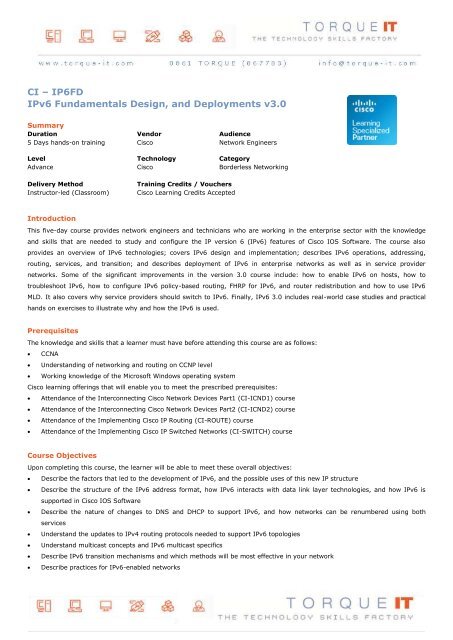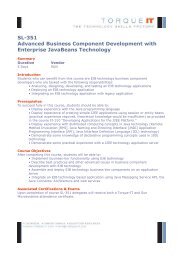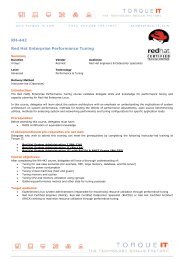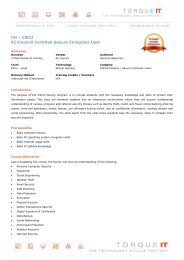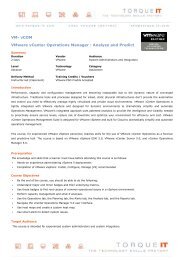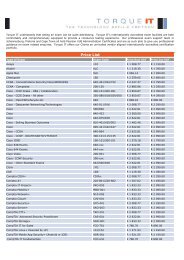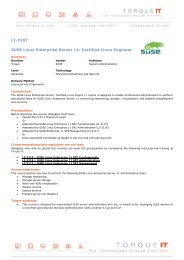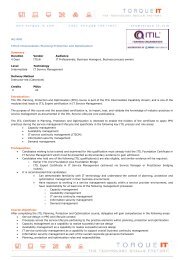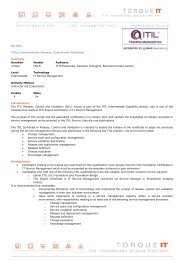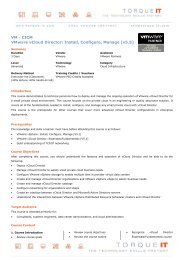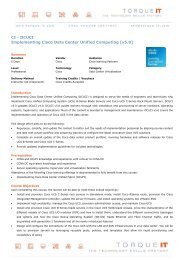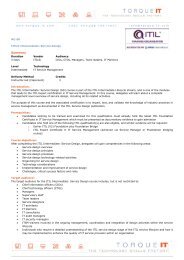CI â IP6FD IPv6 Fundamentals Design, and Deployment ... - Torque IT
CI â IP6FD IPv6 Fundamentals Design, and Deployment ... - Torque IT
CI â IP6FD IPv6 Fundamentals Design, and Deployment ... - Torque IT
You also want an ePaper? Increase the reach of your titles
YUMPU automatically turns print PDFs into web optimized ePapers that Google loves.
<strong>CI</strong> – <strong>IP6FD</strong><strong>IPv6</strong> <strong>Fundamentals</strong> <strong>Design</strong>, <strong>and</strong> <strong>Deployment</strong>s v3.0SummaryDuration Vendor Audience5 Days h<strong>and</strong>s-on training Cisco Network EngineersLevel Technology CategoryAdvance Cisco Borderless NetworkingDelivery MethodInstructor-led (Classroom)Training Credits / VouchersCisco Learning Credits AcceptedIntroductionThis five-day course provides network engineers <strong>and</strong> technicians who are working in the enterprise sector with the knowledge<strong>and</strong> skills that are needed to study <strong>and</strong> configure the IP version 6 (<strong>IPv6</strong>) features of Cisco IOS Software. The course alsoprovides an overview of <strong>IPv6</strong> technologies; covers <strong>IPv6</strong> design <strong>and</strong> implementation; describes <strong>IPv6</strong> operations, addressing,routing, services, <strong>and</strong> transition; <strong>and</strong> describes deployment of <strong>IPv6</strong> in enterprise networks as well as in service providernetworks. Some of the significant improvements in the version 3.0 course include: how to enable <strong>IPv6</strong> on hosts, how totroubleshoot <strong>IPv6</strong>, how to configure <strong>IPv6</strong> policy-based routing, FHRP for <strong>IPv6</strong>, <strong>and</strong> router redistribution <strong>and</strong> how to use <strong>IPv6</strong>MLD. It also covers why service providers should switch to <strong>IPv6</strong>. Finally, <strong>IPv6</strong> 3.0 includes real-world case studies <strong>and</strong> practicalh<strong>and</strong>s on exercises to illustrate why <strong>and</strong> how the <strong>IPv6</strong> is used.PrerequisitesThe knowledge <strong>and</strong> skills that a learner must have before attending this course are as follows: CCNA Underst<strong>and</strong>ing of networking <strong>and</strong> routing on CCNP level Working knowledge of the Microsoft Windows operating systemCisco learning offerings that will enable you to meet the prescribed prerequisites: Attendance of the Interconnecting Cisco Network Devices Part1 (<strong>CI</strong>-ICND1) course Attendance of the Interconnecting Cisco Network Devices Part2 (<strong>CI</strong>-ICND2) course Attendance of the Implementing Cisco IP Routing (<strong>CI</strong>-ROUTE) course Attendance of the Implementing Cisco IP Switched Networks (<strong>CI</strong>-SW<strong>IT</strong>CH) courseCourse ObjectivesUpon completing this course, the learner will be able to meet these overall objectives: Describe the factors that led to the development of <strong>IPv6</strong>, <strong>and</strong> the possible uses of this new IP structure Describe the structure of the <strong>IPv6</strong> address format, how <strong>IPv6</strong> interacts with data link layer technologies, <strong>and</strong> how <strong>IPv6</strong> issupported in Cisco IOS Software Describe the nature of changes to DNS <strong>and</strong> DHCP to support <strong>IPv6</strong>, <strong>and</strong> how networks can be renumbered using bothservices Underst<strong>and</strong> the updates to IPv4 routing protocols needed to support <strong>IPv6</strong> topologies Underst<strong>and</strong> multicast concepts <strong>and</strong> <strong>IPv6</strong> multicast specifics Describe <strong>IPv6</strong> transition mechanisms <strong>and</strong> which methods will be most effective in your network Describe practices for <strong>IPv6</strong>-enabled networks
Describe the st<strong>and</strong>ards bodies that define <strong>IPv6</strong> address allocation, as well as one of the leading <strong>IPv6</strong> deployment issues,multihomingDescribe the deployment strategies that service providers are facing when deploying <strong>IPv6</strong>Describe case studies for enterprise, service provider, branch, <strong>and</strong> access networksTarget AudienceThis course is intended primarily for: Network engineers <strong>and</strong> techniques who are working in the enterprise sectorCourse Content1. Course Introduction Overview Learner Skills <strong>and</strong> Knowledge Course Goal <strong>and</strong> Objectives Course Flow2. Introduction to <strong>IPv6</strong> Explaining the Rationale for <strong>IPv6</strong> Evaluating <strong>IPv6</strong> Features <strong>and</strong>Benefits Underst<strong>and</strong>ing Market Drivers3. <strong>IPv6</strong> Operations Underst<strong>and</strong>ing the <strong>IPv6</strong>Addressing Architecture Describing the <strong>IPv6</strong> HeaderFormat Enabling <strong>IPv6</strong> on Hosts Enabling <strong>IPv6</strong> on Cisco Routers Using ICMPv6 <strong>and</strong> NeighbourDiscovery Troubleshooting <strong>IPv6</strong>4. <strong>IPv6</strong> Services <strong>IPv6</strong> Mobility Describing DNS in an <strong>IPv6</strong>Environment Underst<strong>and</strong>ing DHCPv6Operations Underst<strong>and</strong>ing QoS Support inan <strong>IPv6</strong> Environment Using Cisco IOS SoftwareFeatures5. <strong>IPv6</strong>-Enabled RoutingProtocols Routing with RIPng Examining OSPFv3 Examining Integrated IS-IS Examining EIGRP for <strong>IPv6</strong> Underst<strong>and</strong>ing MP-BGP Configuring <strong>IPv6</strong> Policy-BasedRouting Configuring FHRP for <strong>IPv6</strong> Configuring Route Redistribution6. <strong>IPv6</strong> Multicast Services Implementing Multicast in an<strong>IPv6</strong> Network Using <strong>IPv6</strong> MLD7. <strong>IPv6</strong> Transition Mechanisms Implementing Dual-Stack Describing <strong>IPv6</strong> TunnellingMechanisms8. <strong>IPv6</strong> Security Configuring <strong>IPv6</strong> ACLs Using IPsec, IKE, <strong>and</strong> VPNs Discussing Security Issues in an<strong>IPv6</strong> Transition Environment Underst<strong>and</strong>ing <strong>IPv6</strong> SecurityPractices Configuring Cisco IOS Firewallfor <strong>IPv6</strong>9. Deploying <strong>IPv6</strong> Examining <strong>IPv6</strong> AddressAllocation Underst<strong>and</strong>ing the <strong>IPv6</strong>Multihoming Issue Identifying <strong>IPv6</strong> Enterprise<strong>Deployment</strong> Strategies10. <strong>IPv6</strong> <strong>and</strong> Service Providers Identifying <strong>IPv6</strong> Service Provider<strong>Deployment</strong> Underst<strong>and</strong>ing Support for <strong>IPv6</strong>in MPLS Underst<strong>and</strong>ing 6VPE Underst<strong>and</strong>ing <strong>IPv6</strong> Broadb<strong>and</strong>Access Services11. <strong>IPv6</strong> Case Studies Planning <strong>and</strong> Implementing <strong>IPv6</strong>in Enterprise Networks Planning <strong>and</strong> Implementing <strong>IPv6</strong>in Service Provider Networks Planning <strong>and</strong> Implementing <strong>IPv6</strong>in Branch NetworksAssociated Certifications & Exam.On successful completion of this course students will receive a <strong>Torque</strong> <strong>IT</strong> attendance certificate.


